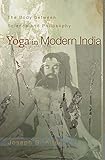Yoga in Modern India : The Body between Science and Philosophy / Joseph S. Alter.
Material type: TextPublisher: Princeton, NJ : Princeton University Press, [2021]Copyright date: ©2005Description: 1 online resource (352 p.) : 10 halftonesContent type:
TextPublisher: Princeton, NJ : Princeton University Press, [2021]Copyright date: ©2005Description: 1 online resource (352 p.) : 10 halftonesContent type: - 9781400843435
- Hindu philosophy
- Knowledge, Theory of
- Metaphysics
- Philosophy, Modern
- Yoga
- SOCIAL SCIENCE / Anthropology / Cultural & Social
- Banaras Hindu University
- Bharatiya Yog Sansthan
- Cartesian dualism
- Freedom Movement
- Indus civilization
- Kabir Baug Matha
- Kaundinya
- Madhavdas Vacuum
- Madhavdas
- addiction to health
- allopathic medicine
- alternative science
- anabolic metabolism
- anthropological methods
- asceticism
- autonomic nervous system
- belief in disbelief
- biochemical experiments
- biochemistry
- biomorality
- capitalism
- cardiovascular endurance
- colonialism
- consciousness
- cultural studies
- deconstruction
- discursive power
- egalitarianism
- embodiment
- empathy
- enlightenment
- ethnographic representation
- feminism
- globalization
- governmentality
- gymnasium
- headstand posture
- heap person
- historiography
- homeopathy
- ideology
- invisible congregation
- jumping jacks
- laboratory
- laghiman
- liberal humanism
- liberation
- materialism
- misunderstanding
- modernization
- national identity
- nostril dominance
- B132.Y6
- online - DeGruyter
| Item type | Current library | Call number | URL | Status | Notes | Barcode | |
|---|---|---|---|---|---|---|---|
 eBook
eBook
|
Biblioteca "Angelicum" Pont. Univ. S.Tommaso d'Aquino Nuvola online | online - DeGruyter (Browse shelf(Opens below)) | Online access | Not for loan (Accesso limitato) | Accesso per gli utenti autorizzati / Access for authorized users | (dgr)9781400843435 |
Frontmatter -- CONTENTS -- ILLUSTRATIONS -- PREFACE -- ACKNOWLEDGMENTS -- PART 1. Introduction and Orientation -- 1 HISTORICIZING YOGA: THE LIFE AND TIMES OF LIBERATED SOULS -- 2 YOGA AND THE SUPRAMENTAL BEING: MATERIALISM, METAPHYSICS, AND SOCIAL REALITY -- PART 2. Yoga’s Modern History and Practice -- 3 SWAMI KUVALAYANANDA: SCIENCE, YOGA, AND GLOBAL MODERNITY -- 4 BIRTH OF THE ANTI-CLINIC: NATUROPATHIC YOGA IN A POST-GANDHIAN, POSTCOLONIAL STATE -- 5 DR. KARANDIKAR, DR. PAL, AND THE RSS: PURIFICATION, SUBTLE GYMNASTICS, AND MAN MAKING -- PART 3. Conclusion -- 6 AUTO-URINE THERAPY—THE ELIXIR OF LIFE: YOGA, AYURVEDA, AND SELF-PERFECTION -- 7 MIMETIC SKEPTICISM AND YOGA: MOVING BEYOND THE PROBLEM OF CULTURE AND RELATIVISM -- NOTES -- GLOSSARY -- REFERENCES -- INDEX
restricted access online access with authorization star
http://purl.org/coar/access_right/c_16ec
Yoga has come to be an icon of Indian culture and civilization, and it is widely regarded as being timeless and unchanging. Based on extensive ethnographic research and an analysis of both ancient and modern texts, Yoga in Modern India challenges this popular view by examining the history of yoga, focusing on its emergence in modern India and its dramatically changing form and significance in the twentieth century. Joseph Alter argues that yoga's transformation into a popular activity idolized for its health value is based on modern ideas about science and medicine.Alter centers his analysis on an interpretation of the seminal work of Swami Kuvalayananda, one of the chief architects of the Yoga Renaissance in the early twentieth century. From this point of orientation he explores current interpretations of yoga and considers how practitioners of yogic medicine and fitness combine the ideas of biology, physiology, and anatomy with those of metaphysics, transcendence, and magical power.The first serious ethnographic history of modern yoga in India, this fluently written book is must reading not only for students and scholars but also practitioners who seek a deeper understanding of how yoga developed over time into the exceedingly popular phenomenon it is today.
Mode of access: Internet via World Wide Web.
In English.
Description based on online resource; title from PDF title page (publisher's Web site, viewed 01. Dez 2022)


